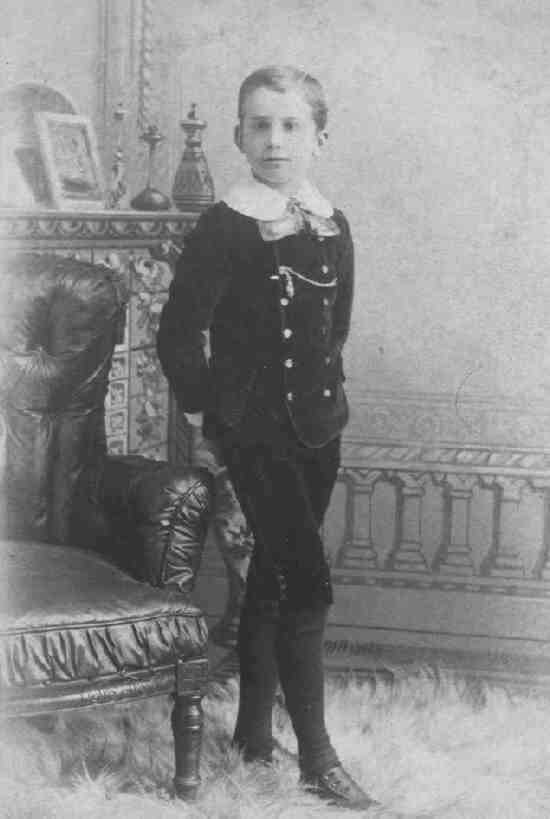
Early Velvet Suits

Figure 1.--It was not just little boys who wore velvet suits. This American boy from Cincinnati, Ohio looks to be about 11 or 12 years old and wears an elegant velvet suit. It is not in the Fauntleroy style as the jacket is full size. He also wears a Peter Pan collar rather than a large Fauntleroy lace and ruffled collar. The image is undated, but HBC suspects tst it was probably about 1875.
|
Velvet has been used used for boys clothing since specialized boys clothing appeared after the mid-18th Century. Many better skeleton suits in the late 18th and early 19th century were made from velvet. This was especially true for boys from aristocratic or wealthy families. Boys were dressed in velvet suits and lace collars well before the style was popularized in America by Mrs. Frances Hogdson Burnett in the 1880s. Many of these suits did not ave the fancy lace and ruffled styling of the Fauntleroy suit.
The earliest velvet suits known to HBC are the skeleton suits worn in the early 19th century. Skeleton suits first appeared in the late 18th century. They were made in many materials, but one of the most elegant materials was velvet. The skeleton suit was a fashion staple for boys. It came in one and two piece styles with numerous buttons in necessary places. It was worn during the French Empire period and the
British Regency era Skeleton suits were widely worn by boys
throughout Western Europe and America.
Precursor Velvet Suits
There were many precursors to the Fauntleroy suit. Mrs Burnett did not invent the costume. Elegant velvet suits had become recognized dress for small boys as a variant from the ubiquitous sailor for every day wear. [Roger Lancelyn Green (Tellers of Tales, 1946.] Velvet suits were being worn in the 1860s, although not will all the Fauntleroy trimmings.
Mrs. Burnett began dressing her boys, Vivian and his older brother Lionel, in velvet suits well before she wrote Little Lord Fauntleroy. Their outfits were similar to dressy outfits which had been acceptable fashions worn by middle-class and wealthy boys for at least a generation. The mmediate precursors were probably French Crispin suits which had appeared at mid-century. Mrs. Burnett mush have noted these outfits when she lived in Paris. American fashion magazines had introduced these suits to American mothers by the 1860s. The influential American Peterson's Magazine described the following outfit in a 1865 issue, more than 20 years before the appearance of Little Lord Fauntleroy: "A little boy's knickerbocker suit of black velvet. It is trimmed with fur and fastened at the waist with a belt of leather. Black velvet cap. [Peterson's Magazine, December, 1865, p. 460.] This was fully 20 years before the publication of Cedric Erols' exploits.
We see a range of velvet suits in the 1870s. See for example a Syracuce boy in the 1870s.
Velvet suits can be seen in illustrations in Aunt Judy's Magazine and Little Folk from the beginning of the 1880s. A woman's magazine in 1885, a few months before the story appeared in St. Nicholas, described a suit "for a little fellow of seven". It was a velvet suit with a Vandyke collar. The suggested collar was sapphire blue with a sash of pale pink which one author later commented made Cedric's black suit seem almost austere. Mrs. Burnett must have drawn on these developing styles in the suits she fashioned
for her boys. While Mrs. Burnett did not invent the suits, her book and illustrations undeniably popularized the fashion for a generation of little and not so little boys.
By the 1880s, one of the most popular styles of suits for boys were the l7th-century-style suits in black velvet (also called cavalier suits). They were commonly worn by boys from 4 to 7 or 8 years of age but some older boys wore them as well. The custom of some mothers of delaying a boy's first haircut as long as possible added to the "cavalier" effect. While this custom was by no means universal, it was very fashionable and a not small number of boys found them selves wearing ringlet curls. For these reasons, it is probably accurate to say that thousands of American boys were dressing like Little Lord Fauntleroy several years before the story was published. Certainly two were; an 1885 photograph of Vivian Burnett in his velvet cavalier suit was sent to illustrator Reginald Birch as a model for his drawings of Cedric Errol. [Vivian Burnett, The Romantick Lady, (New York: Charles Scribner's Sons, 1927), p. 136.] Vivian's older brother Lionel and many other American boys wore similar outfits.
The first velvet boy's suit was probably the skeleton suit. We are not sure when velvet jackets with matching trousers were first made. It is likely that they first appeared in the 1850s or 60s. They were made in a wide variety of styles. The earliest image that HBC currently has dates to the 1870s. These suits differe from the classical Fauntleroy suit in several different ways. They were not worn with the elaborate lace and ruffled trim and enormous bows and collars. The jackets were also larger, generally covering the blouse. There were some suits, however, which seem to be precurosors of the Fauntleroy styles. Some early velvet suits were worn with lace and ruffled trim, but not in the sort jackets of the classic Fauntleroy suit.
HBC

Fauntleroy Related Pages:
Return to [Main Fauntleroy page]
Return to [Main velvet suit page]
Return to [Main fabric page]
[]
[Classic period]
[Edwardian period]
[Final era]
[Modern velvet suits]
Navigate the Boys' Historical Clothing Web Site:
[Return to Main Fauntleroy movie page]
[Introduction]
[Activities]
[Biographies]
[Chronology]
[Clothing styles]
[Countries]
[Bibliographies]
[Contributions]
[FAQs]
[Glossaries]
[Satellite sites]
[Tools]
[Boys' Clothing Home]
Created: May 15, 1999
Last updated: 2:47 AM 4/18/2006



